A surprise for us: According to the local literature and BC guidebooks, the town of Oliver, in the southern part of the valley, is located at the northernmost end of the Sonoran Desert, Canada's only desert. Annual rainfall is approximately 12 inches, a small amount of which is snow. There's a Desert Centre in Osoyoos, featuring vegetation similar to that surrounding Tucson, but we decided to skip that tour in favour of more unfamiliar experiences. Our local guidebooks and information centres have led us to believe that the Sonoran desert is located only in southwestern Arizona and southeastern California, Baja California and Sonora, Mexico. My question is: What deserts link the two areas?The Okanagan’s grape production currently covers some 5000 acres and is the oldest and largest wine-producing region in the province. The source of premium grape varieties, this region has more than 70 wineries and supplies 95 % of the province’s wine. Y.T. suggested that we visit the estate vineyards of Mission Hills Winery near Kelowna. This winery is noted for its world-class wines and its beautiful architecture.
We drove to a hilltop overlooking Lake Okanagan and parked near a beautiful rose garden at the entrance to the estate.
 Drip irrigation is used in this vineyard. Rose bushes are planted at the end of every row. The roses are more sensitive to temperature changes and insect invasion, and therefore act as a warning device.
Drip irrigation is used in this vineyard. Rose bushes are planted at the end of every row. The roses are more sensitive to temperature changes and insect invasion, and therefore act as a warning device.
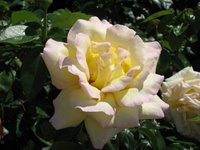 We were told that sensors have been installed to warn of threat to the vines. If the sensors are activated, alarms go off in the homes of the vineyard workers.
We were told that sensors have been installed to warn of threat to the vines. If the sensors are activated, alarms go off in the homes of the vineyard workers.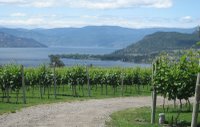
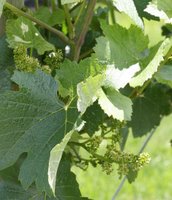 We toured the grounds
We toured the grounds

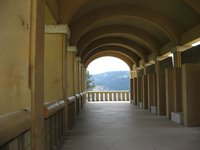
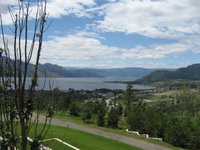 and the cellars
and the cellars
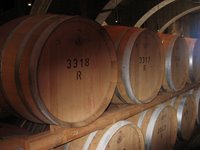 and participated in a tasting of five different wines.
and participated in a tasting of five different wines.  We then headed to Osoyoos for our last night on the road.
We then headed to Osoyoos for our last night on the road.

2 comments:
I'd always wondered about the roses at the end of rows of vines (we have them here in NZ too.) Now I know - thanks Pam!
chiefbiscuit - I should look up NZ wineries. We drink Australian wines, but don't know anything about NZ wines. Are they exported much?
Post a Comment